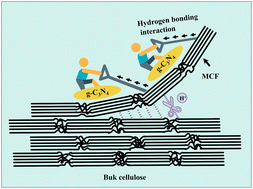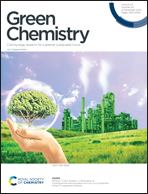One-pot preparation of micro-fibrillated cellulose fiber (MCF) through the synergistic action of g-C3N4 and a diluted acid†
Abstract
Fibrillated cellulose with outstanding mechanical strength, biocompatibility, biodegradability and a high specific surface area has attracted widespread attention from researchers. Mechanical fibrillation is the most common preparation method, but a complex pretreatment and high energy consumption are inevitably required. In this study, amino-enriched g-C3N4 as both a relatively weak hydrogen bond donor and a solid base was used in MCF preparation. Almost all kinds of cellulose (without pretreatment) can be directly converted into MCF with a diameter of 200–300 nm with the synergistic action of g-C3N4 and acid (0.02 mol L−1 H2SO4) in 10 min under microwave irradiation. The length of the micro-fibrillated cellulose fiber (MCF) is consistent with the size of the cellulose crystalline region in raw materials. Furthermore, the obtained MCF successfully achieved real-time adsorption of a disperse blue dye and the residue contains a large amount of g-C3N4, which can be used for efficient photocatalytic degradation of rhodamine B. This research, into breaking the hydrogen bonds between fibril bundles by solid–solid interactions rather than mechanical fibrillation, provides a new strategy for MCF preparation.



 Please wait while we load your content...
Please wait while we load your content...